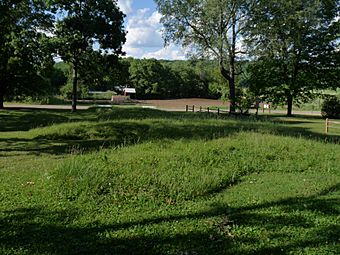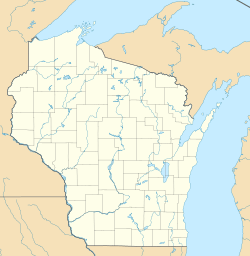Man Mound facts for kids
|
Man Mound
|
|

Looking down at the mound from the headdress
|
|
| Location | East of Baraboo off WI 33 on Man Mound Road |
|---|---|
| Area | 0.3 acres (0.12 ha) |
| NRHP reference No. | 78000138, 16000861 |
Quick facts for kids Significant dates |
|
| Added to NRHP | November 30, 1978 |
| Designated NHL | October 31, 2016 |
The Man Mound is a giant, human-shaped mound of earth. It's located in Sauk County, Wisconsin, near the city of Baraboo. People from the Late Woodland period built it a very long time ago. This amazing mound is the only human-shaped earthwork left in North America! It looks like a person with horns, and it was probably important for their religion or special ceremonies.
The Man Mound was saved as a county park in 1908. Later, it was added to the National Register of Historic Places in 1978. In 2016, it became a National Historic Landmark, which means it's a really important historical site.
What Does the Man Mound Look Like?
The Man Mound is a huge figure shaped like a human. Its head points south, and its feet originally pointed west. The figure's head has two horns. These might have been part of a special headdress worn by the person it represents.
When it was first built, the mound was about 214 feet (65 m) long. That's longer than a tennis court! It stood about 2.5 feet (0.76 m) tall from the ground. Sadly, parts of the mound were damaged over time. The legs and feet were destroyed when Man Mound Road was built. A cow pasture also covered some of it. Now, the mound is about 50 feet (15 m) shorter than it used to be. To help people imagine its full size, the legs have been drawn across the road. There are also plastic cutouts of the feet in the cow pasture.
The Man Mound is one of only five human-shaped mounds ever found in North America. All five were in Wisconsin. But the Man Mound is the only one that is still standing today! The other mounds included the La Valle Man Mound and two others in Richland County. A few other possible human-shaped mounds have been seen in southern Wisconsin, but they haven't been fully confirmed.
The History of the Man Mound
People from the Late Woodland period built the Man Mound between 750 and 1200 AD. This was a time when many "effigy mounds" were being built. Effigy mounds are earthworks shaped like animals or humans. Often, a large animal or human mound would be surrounded by smaller, geometric mounds.
These mounds were often used as burial sites. They also held deep religious meaning for the people who built them. While the Man Mound hasn't been dug up, experts think it might also be a burial site. The human figure it shows could have been a shaman (a spiritual leader) or even a god. Because the mound is still mostly complete, it can teach us a lot about the beliefs and culture of the Late Woodland people.
In 1859, a man named William Canfield was the first European settler to find and study the mound. His discoveries created some excitement. But by the late 1800s, people didn't pay much attention to the mound anymore.
Then, two archaeologists from the Wisconsin Archaeological Society rediscovered it. In 1907, the Wisconsin Archaeological Society and the Sauk County Historical Society worked together. They bought the land where the mound is located. The very next year, in 1908, they made the mound a county park. This was done to make sure it would be protected for many years to come.
The Man Mound was added to the National Register of Historic Places on November 30, 1978. It was then named a National Historic Landmark on October 31, 2016.



